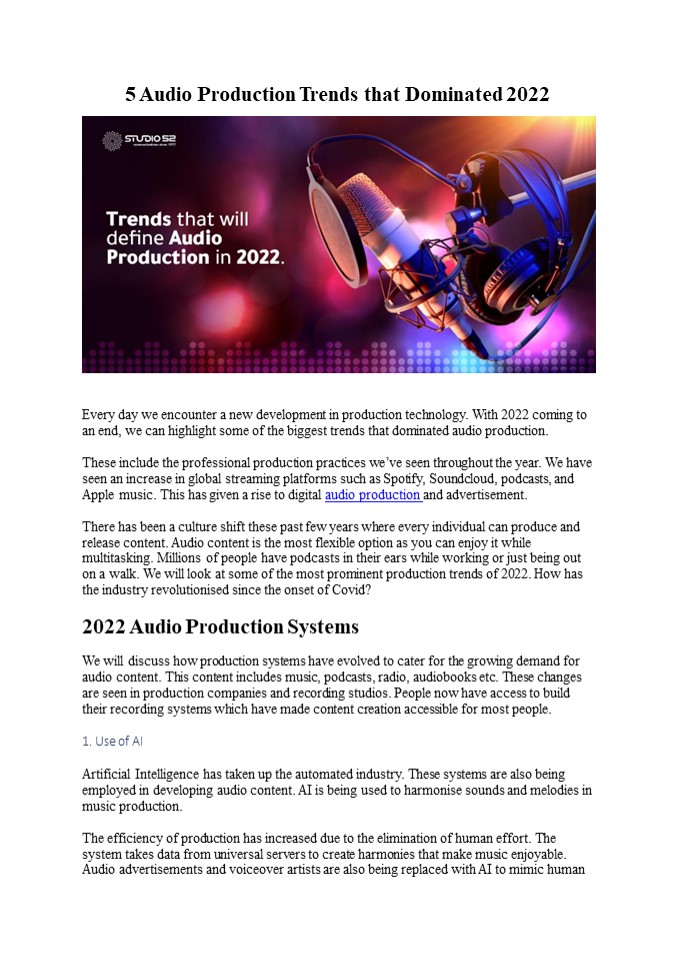5 Audio Production Trends that Dominated 2022 PowerPoint PPT Presentation
Title: 5 Audio Production Trends that Dominated 2022
1
5 Audio Production Trends that Dominated 2022
Every day we encounter a new development in
production technology. With 2022 coming to an
end, we can highlight some of the biggest trends
that dominated audio production. These include
the professional production practices weve seen
throughout the year. We have seen an increase in
global streaming platforms such as Spotify,
Soundcloud, podcasts, and Apple music. This has
given a rise to digital audio production and
advertisement. There has been a culture shift
these past few years where every individual can
produce and release content. Audio content is
the most flexible option as you can enjoy it
while multitasking. Millions of people have
podcasts in their ears while working or just
being out on a walk. We will look at some of the
most prominent production trends of 2022. How has
the industry revolutionised since the onset of
Covid? 2022 Audio Production Systems We will
discuss how production systems have evolved to
cater for the growing demand for audio content.
This content includes music, podcasts, radio,
audiobooks etc. These changes are seen in
production companies and recording studios.
People now have access to build their recording
systems which have made content creation
accessible for most people. 1. Use of
AI Artificial Intelligence has taken up the
automated industry. These systems are also being
employed in developing audio content. AI is being
used to harmonise sounds and melodies in music
production. The efficiency of production has
increased due to the elimination of human effort.
The system takes data from universal servers to
create harmonies that make music enjoyable.
Audio advertisements and voiceover artists are
also being replaced with AI to mimic human
2
- speech. This has led to companies developing AI
technology instead of hiring people for the job. - The Cloud
- It has been a fantasy for broadcasting
professionals to be able to produce audio through
the cloud. It has become part of the
conversation and cloud-based production systems
are being developed. - Media outlets are spending a big part of their
budget on cloud-based applications. It allows
smaller broadcasting channels to produce content.
And the pandemic put this process at an
accelerated pace. - Bigger companies have also made steps to
integrate the cloud into their production
process. We can expect this trend to grow even
more in the coming years. The cloud is being used
to make collaborative and remix audio content.
With the onset of video and audio content on
social media, more and more users are shifting to
the cloud. - This is done through virtual music production
studios used to integrate audio. The production
systems need to be developed at larger scales for
future use. The entire production process
includes catering artists, hiring crews and
financing on-site studio requirements. With the
cloud, all of these processes can be completed in
a virtual setup. - Virtualisation
- The concept of having a virtual recording and
production system has caused us to revisit the
use of hardware. The cloud production of audio
content can be accessed from all parts of the
world. - Software is being developed to replace the need
for studios. These technologies are capable of
recording and editing data to acquire a final
product. Audio files can not only be stored but
integrated with multiple files. This is an
opportunity for companies to completely
virtualise the production process. - Brands are moving towards software development
and apps to facilitate cloud production. This is
the process future generations will use to create
content. There are abundant opportunities to
develop different types of audio content
according to the clients demand.
3
Although this live audio is being recorded by
local artists, it has yet to invoke serious
interest in the masses. Many social media
platforms such as TikTok and Instagram are now
shifting towards audio content rather than
pictorial. Many celebrities such as the CEO of
Facebook, Mark Zuckerberg have used these
platforms for unfiltered speech. An effort is
being put in by influential people to make live
audio universally accepted. This includes
concert arenas being filled in the virtual world
by musicians. This system needs to be perfected
to increase its use. Any bugs and chances of lag
need to be eliminated to improve audio
quality. 5. Metaverse Fortnite made it possible
for spatial audio to exist in the form of
concerts and music arenas. The metaverse is a
virtual reality where you can exist as a rendered
form of yourself. Your voice is the only thing
that stays true to its source. Your avatar will
survive long after you will, carrying on your
voice. Engineers are developing a more immersive
audio experience for the individuals existing in
the metaverse. Many artists are taking up the
challenge of recording music in spatial
audio. This system is still in the early stages
of development hence we can expect this trend to
grow in the coming years. This even gives a
chance for intermixing different music genres to
produce hybrid audios. Read more -
https//studio52.tv/blog/5-audio-production-trends
-that-dominated-2022/

